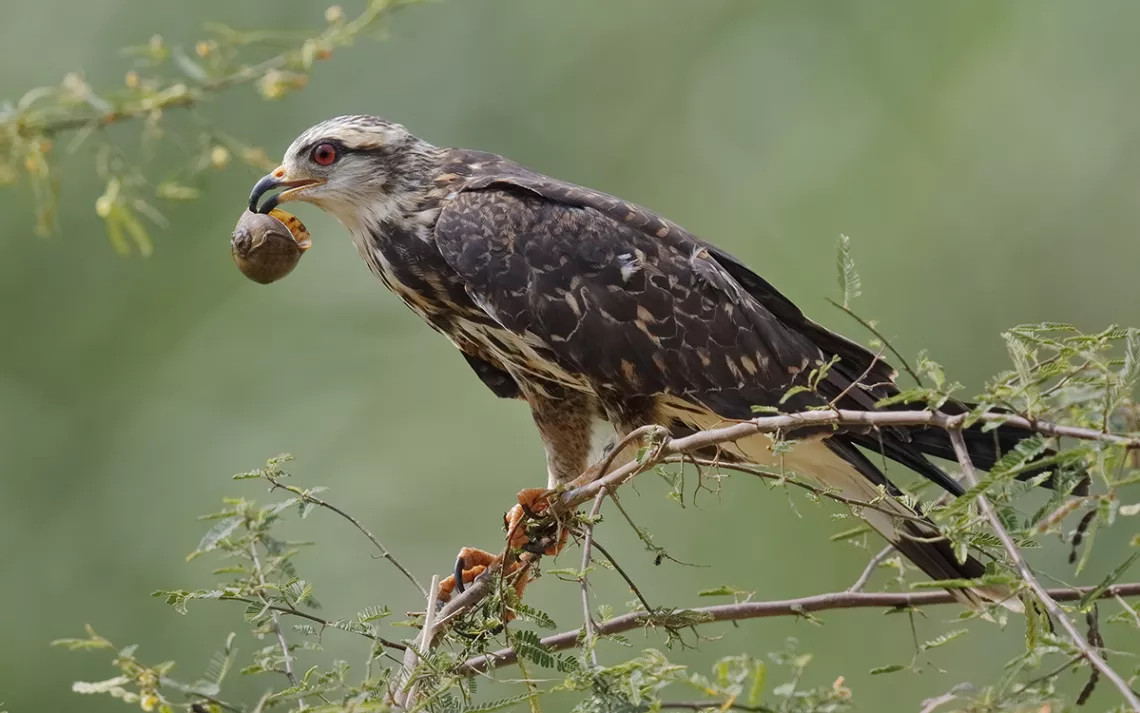Overnight Evolution
Florida’s snail kites save themselves by stepping up their game

Photo by BrianLasenby/iStock
It’s not hard for the snail kite to plan its daily menu. The endangered raptor eats only one food: apple snails, and a lot of them—10,000 a year per bird. Catching the freshwater snails is a laborsome venture that involves waiting until the snail comes to the surface to breathe and—at the exact right moment—swooping down to grab it. Employing its perfectly adapted curved beak, the kite then extracts its escargot and repeats the process 27 more times, every day.
This specialist bird has been hit hard by habitat declines and other changes in the Florida wetlands it calls home. From 2000 to 2007, scientists noticed a steep decline in the number of snail kites, owing in part to two major droughts that left their wetlands parched. The decline was also affected by the rarity of the apple snail, which lives in a very particular habitat and has a relatively short lifespan. Without its snails, the snail kite's chances of survival were looking poor—until an unlikely invader found its way to Florida.
It turns out there is more than one variety of apple snail. The non-native South American apple snail likely made its way to the Sunshine State via the pet trade, possibly when a rash aquarium owner released the species into the wild. The South American snail, which can grow to nearly the size of a tennis ball, quickly outpaced its native cousin, which is only the size of a ping-pong ball. It lays more eggs, lives longer, and can adapt to more diverse habitats than the native variety, and so spread widely all over the Florida wetlands.
You may sense where this story is going. A recent study in Nature Ecology & Evolution found that the snail kite has rapidly evolved so as to be able to forage on this new, larger prey. The bills of the raptor, says Robert Fletcher, coauthor of the study and associate professor in the department of wildlife ecology and conservation at the University of Florida, have increased in size since the invasion of the South American snail.
“Bill size and shape are heritable, meaning that birds with larger bills pass the trait onto their offspring, and larger-billed birds have a higher survival rate,” says Fletcher. Parent kites that are able to handle the larger apple snail bring it back to their young, who are more likely to grow stronger, survive, and breed in turn. The first couple months of life are the most dangerous for young snail kites, who are just learning how to forage on their own and aren’t yet skilled at it. “Bigger-bill snail kites seem to survive much better during this time,” says Fletcher. The result: Numbers of large-bill snail kites have tripled in the past decade.
Bill size, of course, is the classic demonstration of the inheritability of evolutionarily advantageous traits. Charles Darwin arrived at the Galápagos Islands in 1835 and encountered a panoply of finch varieties. Their common ancestor had arrived on the islands about 2 million years ago, and since then had evolved into 13 recognized species with differing traits, bill size being one of the most prominent.
The South American apple snails are exceptions to Florida’s mostly unhappy experience with invasive species. For example, the state is now home to thriving populations of pythons and boa constrictors; a 95-pound boa was recently captured on No Name Key in the Florida Keys. Invasive snakes are wiping out native foxes and rabbits as well as raccoons, deer, opossums, and bobcats. And lionfish, found in the waters surrounding Florida, have decimated the area’s marine species.
Nor is the snail kite’s future secure. “Habitat destruction is a continuing threat, as much of the snail kite’s home has been lost to farming and development,” says Frank Jackalone, Florida Chapter director for the Sierra Club. Water pollution caused by pesticide runoff has also had devastating repercussions for Florida, causing poisonous algae to blanket important water sources. And while the South American snails are valuable as a food source for the snail kite, they’re also muscling out the Florida apple snails, which are becoming increasingly rare.
 The Magazine of The Sierra Club
The Magazine of The Sierra Club



